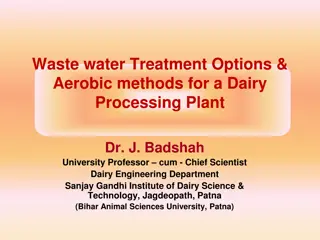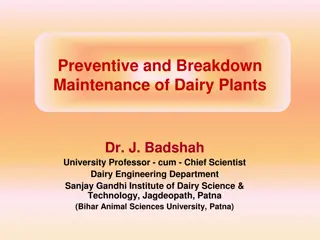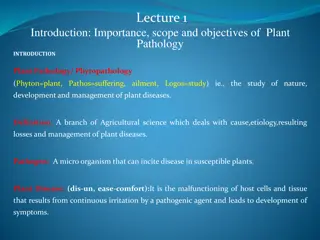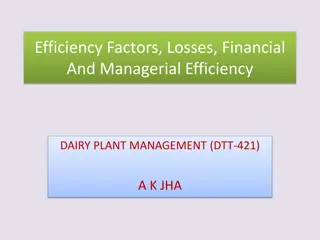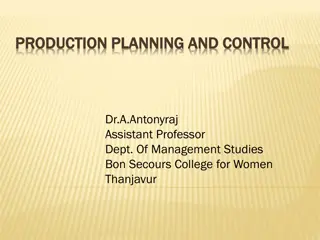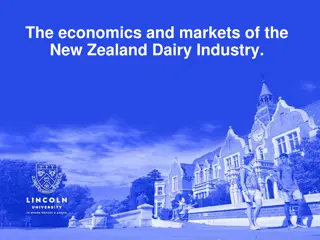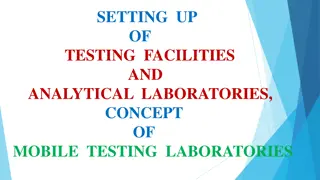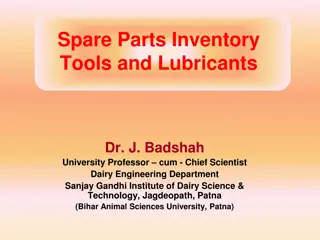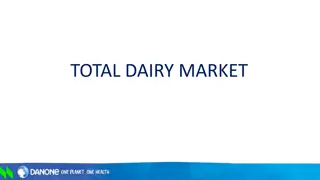Introduction to Production Planning and Control in Dairy Plant Management
Production planning and control in dairy plant management involve the strategic processes of production, planning, and control to ensure efficient manufacturing operations. Planning is crucial in determining what, how, how much, and where to produce, while control involves monitoring and adjusting production activities to meet goals. Production planning ensures future achievement in product type, volume, quality, time, costs, and resources required. It is a technique that forecasts and manages the long-run production process to ensure efficiency and timely completion of operations.
Download Presentation

Please find below an Image/Link to download the presentation.
The content on the website is provided AS IS for your information and personal use only. It may not be sold, licensed, or shared on other websites without obtaining consent from the author.If you encounter any issues during the download, it is possible that the publisher has removed the file from their server.
You are allowed to download the files provided on this website for personal or commercial use, subject to the condition that they are used lawfully. All files are the property of their respective owners.
The content on the website is provided AS IS for your information and personal use only. It may not be sold, licensed, or shared on other websites without obtaining consent from the author.
E N D
Presentation Transcript
PRODUCTION PLANNING AND CONTROL DAIRY PLANT MANAGEMENT (DTT-421 A K JHA
Production Production is the process by which goods or services are created. It is a means of converting raw materials into finished product by performing a set of manufacturing operations predetermined sequences that transforms material from a given to desired form. in a
Planning Planning means preparing the scheme in advance before the actual work is started. It is predetermination of future course of action to meet the desired objectives. Before starting the production it is necessary to decide in advance what to produce, how to produce, how much to produce and where to sell.
Production Planning Production predetermination of future achievement in type of products, volume of production, quality time, manufacturing cost and the resources required. It analyses all the problems that may arise and decides in advance how to address them. planning is the
Production Planning Production planning is a technique of forecasting steps involved in the long run production process, taking them at the right time, in the right degree and trying to complete the operations efficiently. It considers three fundamental questions What type of work has to be undertaken? How this work will be done? When the work has to completed
Control Control means supervision of all the relevant operations with the help of control mechanism that feeds back the progress of the work. Controlling is made by comparing the actual performance with the present standards and deviations, if any, are analysed to take corrective measures.
Production control It is process to track and control production flow, amount of resources, and deviations (if any) from the planned actions. It includes arrangements for mid course correction in case of deviations from the original plan so that the production can proceed as per the original plan. In nutshell, production control ensures all which is required organizational goal in accordance with the rules established and instructions issued. to pursue the
Production Planning and Control (PPC) The PPC may be defined as the direction and coordination of the firms material and physical facilities towards the predetermined production goals in the most efficient and economical manner. accomplishment of
Production Planning and Control (PPC) Gordon and Carson observed that production planning and control involve generally in the organization and planning of manufacturing process. It consists of the planning of routing, scheduling, dispatching, inspection, and coordination, control of materials, methods machines, tools and operating times. The ultimate objective is the organization of the supply and movement of materials and labour, machines utilization and related activities, in order to bring about the desired manufacturing results in terms of quality, quantity, time and place.
PPC Contd.. Planning initiates action while control is an adjusting process, providing corrective measures for planned development. Production control regulates and stimulates the manufacturing beginning to the end. process from the
Benefits of Production Planning & Control Optimum utilization of capacity PPC helps the entrepreneur in scheduling the tasks and production runs, and thereby ensures that the productive capacity does not remain idle. PPC eliminates undue queuing up of tasks by proper allocation of tasks and resources to the production facilities.
Benefits of PPC Contd. Inventory control Proper PPC will help the entrepreneur to resort to just- in- time systems and thereby reduce the overall inventory. It also ensures that the right supplies are available at the right time. Economy in production time PPC will help the entrepreneur to reduce the cycle time and increase the turnover via proper scheduling. Ensure quality A good PPC ensures adherence to the quality standards so that quality of output is ensured. To sum up we may say that PPC is of immense value to the entrepreneur in capacity utilization and inventory control. More importantly it improves his response time and quality. As such effective PPC contributes to time, quality and cost parameters of entrepreneurial success.
Objectives of Production Planning & Control The ultimate objective of production planning and control is to contribute to the profits of the enterprise. This is accomplished by keeping the customers satisfied through meeting of delivery schedules. Specific objectives of production planning and control are to establish routes and schedules for work that will ensure the optimum utilization of materials, workers, and machines and to provide the means for ensuring the operation of the plant in accordance with these plans.
Steps in Production Planning & Control Production planning Production control planning Routing Scheduling Loading Dispatching Following up Inspection operations and to ensure that this sequence is strictly followed. of corrective sequence of
Routing Routing is the first step in production planning and control. Routing can be defined as the process of deciding the path (route) of work and the sequence of operations. Routing fixes in advance: The quantity and quality of the product. The men, machines, materials, etc. to be used. The type, number and sequence of manufacturing operations, and The place of production. In short, routing determines What , How much , With which , How and Where to produce. The main objective of routing is to determine (fix) the best and cheapest sequence of operations and to ensure that this sequence is followed in the factory.
Different activities in Routing Routing procedure involves following activities: An analysis of the article to determine what to make and what to buy To determine the quality and type of material Determining the manufacturing operations and their sequence A determination of lot sizes Determination of scrap factors Organization of production control forms
Loading The next step is the execution of the schedule plan as per the route chalked out which includes the assignment of the work to the operators at their machines or work places. Gantt Charts are most commonly used in small industries in order to determine the existing load and also to foresee how fast a job can be done. It is a type of bar chart that illustrates project schedule. The charts explain the start and finish dates of terminal elements and summary elements of a project.
Scheduling Scheduling is the last of the planning functions. It determines when an operation is to be performed, or when work is to be completed; the difference lies in the detail of the scheduling procedure. In a centralized control situation - where all process planning, loading, and scheduling for the plant are done in a central office- the details of the schedule may specify the starting and finishing time for an operation. On the other hand, the central schedule may simply give a completion time for the work in a given department.
Production control Production control is the process of planning production in advance of operations, establishing the exact route of each individual item part or assembly, setting, starting and finishing for each important item or the finishing production and releasing the necessary orders as well as initiating the necessary follow-up to have the smooth function of the enterprise
Dispatching Dispatching is release of orders and instructions for starting of the production of an item as per the route sheet and schedule chart. Movement of materials to different workstations Movement of tools and fixtures necessary for each operation Beginning of work on each operation Recording of time and cost involved in each operation Movement of work from one operation to another in accordance with the route sheet Inspecting or supervision of work Dispatching is an important step as it translates production plans into production.
Follow Up Every determination of the progress of work, removing bottlenecks in the flow of work and ensuring that the productive operations are taking place in accordance with the plans. Follow up delays or deviations from the production plans. It helps to reveal defects in routing and scheduling, misunderstanding of orders and instructions, under loading or overloading of work etc. production programme involves
Inspection This is mainly to ensure the quality of goods. It can be required as effective agency of production control. Corrective measures Corrective action may involve any of those activities of adjusting the route, rescheduling of work, changing the workloads, repairs and maintenance of machinery or equipment, control over inventories of the cause of deviation is the poor performance of the employees. Certain personnel decisions like training, transfer, demotion etc. may have to be taken. Re-planning Re-planning is not a corrective action. Re-planning revises routes, loads, and schedules; a new plan is developed. In manufacturing this is often required. Changes in market conditions, manufacturing methods, or many other factors affecting the plant will often call for re-planning.



